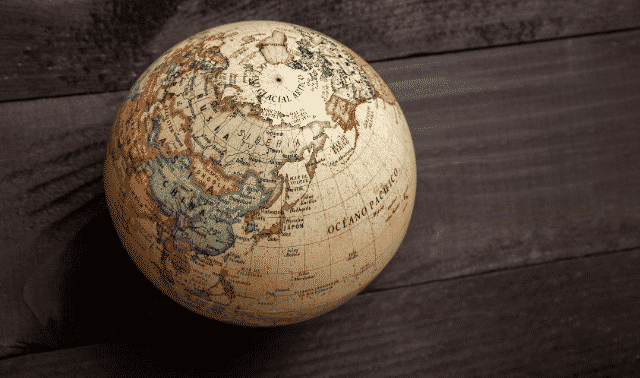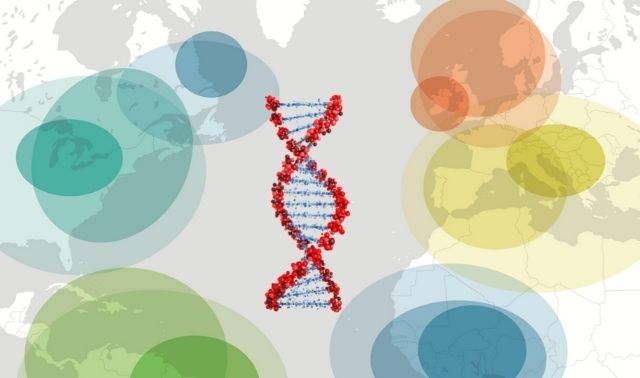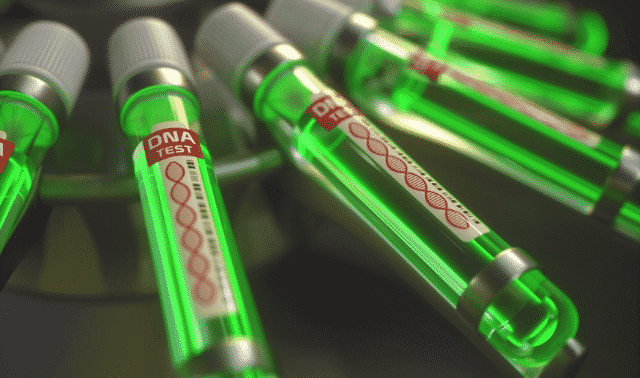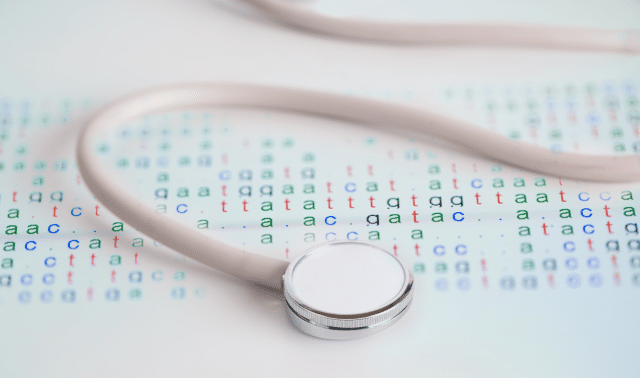Sign up for the Family Tree Newsletter Plus, you’ll receive our 10 Essential Genealogy Research Forms PDF as a special thank you!
Get Your Free Genealogy Forms
"*" indicates required fields

Q: What can I do with my ethnicity estimates?
A: I used to tell people that your ethnicity results were like a coffee table piece: pretty to look at, but not very useful.
But that has changed.
It has changed because our DNA testing companies have worked hard to expand their reference populations—the people they are comparing you against. That means that instead of breaking down your heritage into a few broad and general categories, some of companies can now break up the world into over a thousand different groups.
This means you can now turn to your ethnicity results for clues about your family history. In fact, whenever you are looking to break down a brick wall in the last five to six generations, I recommend reviewing your ethnicity results as a first step. In that review you are looking for anything that seems unfamiliar when compared to the rest of your known family history.
An obvious example would be noticing a Jewish percentage when you were previously unaware of a connection to that population. But you can look for even more subtle clues, like connections to Scandinavia or the Iberian peninsula. We have to be careful, as there aren’t any definite time stamps on our ethnicity results. So that means that connections to these large swaths of land may or may not have occurred in the last 300 years—but it is a start. At 23andMe you can review your Ancestral Timeline to see how far back they estimate you should connect to a certain place, but at other companies you are left to guesstimate.
Both 23andMe and AncestryDNA provide an extra layer to your ethnicity results that helps to define the locations of your ancestors in a more specific timeframe. At 23andMe you can find these more specific locations by just drilling down within each ethnicity category. For example, I am 42% British and Irish. If I click on that category I am taken to a second page reveals that I am not just British and Irish, but it is highly likely that I am from one of ten (of 165) specific regions in the United Kingdom, and it is only possible (so less likely) that I am from one of four (of 26) administrative regions in Ireland. The best part is, they expect my connection to be in the last 200 years.
AncestryDNA targets that same genealogical sweet spot of 200 years in their Genetic Communities. Based on a completely different (and more accurate) technology than the rest of the ethnicity results, many of these communities focus on migration patterns. For example, there are hundreds of communities devoted to the United States, as well as settlers to New Zealand and Australia. There are nearly a hundred communities devoted to African Americans. Membership in one of these communities guarantees (yup, you read that right) you have an ancestor from that place.
At MyHeritage, Family Tree DNA, 23andMe and AncestryDNA you can compare your ethnicity results with those of your matches. This might be helpful if you are looking for a DNA match from a specific population group to help you fill in your missing ancestor. Just the other day I was working with a client who had one Jewish line we were trying to place. So to help us narrow down the pool of matches we need to investigate, we looked for those who had Jewish ethnicity.
So what are you waiting for? Head out and take another look at those ethnicity results to see if maybe, just maybe, they might be just the clue you need to move forward in your research.
Q: Which company has the best ethnicity estimates?
A: First of all, there are three factors that affect the accuracy and usefulness of ethnicity estimates you receive from a testing company, no matter which one you choose. We’ll save the first two (fancy math and timing) for a later discussion. But the most relevant to your question are the reference populations—the people a company is comparing you against.
Reference Populations
These reference populations are made up of regular people living today whose DNA can be used to represent the typical genetic makeup of a particular area. Each person in a reference population had grandparents who all lived within 60 miles of each other in a particular place. But if a testing company doesn’t have a reference population that reflects your ancestral makeup, your results won’t be able to provide detailed, accurate information on where your DNA is from.
For example, Family Tree DNA doesn’t have an ethnicity category specifically for Ireland. So even if you’re 100-percent Irish, you won’t find the term “Irish” in your DNA test results. Rather, you’ll be in the “British Isles” category. That result might not surprise you, but someone with ancestry in Poland probably wouldn’t find “Broadly European” very helpful. That result is technically accurate, but it’s too broad to be interesting or useful.
So, to return to your question:
The best ethnicity estimates will come from the company that has your ancestral population(s) as a reference population.
Each of the major companies provides a complete list of their reference populations. So you can check that list to determine which company may be best for your particular mix of heritage.
DNA Companies’ Areas of Speciality
All of the major companies are going to be good at providing a basic background for those of Western European descent. (Family Tree DNA is a decent baseline.) But some companies also excel in other areas of the world. Here’s a quick rundown of the major companies and their areas of expertise:
- 23andMe: Eastern European or South/Central American ancestry
- AncestryDNA: DNA Migrations tools that help researchers determine where their ancestors were in the last 200 years, and what larger movements of people they may have been part of
- Living DNA: The United Kingdom, with 21 subsets that provide more detailed results there (e.g., 12 percent Northumbershire, 6 percent Devon)
- MyHeritage DNA: Five Jewish reference populations, plus some other unique populations like Indigenous Amazonian and Inuit
No matter which company you choose, be prepared for changes and updates. Ethnicity estimates are an ongoing area of research.
For more on which test is best, check out Shannon Combs-Bennett’s article that shares her experiences with each of the “big five” services.
A version of this article appeared in the September 2019 issue of Family Tree Magazine.
Q: Why do my DNA ethnicity results keep changing?
A: This is a question I get asked often. Implied within it is a statement: Ethnicity results shouldn’t change. But is that true?
It feels true because of the things we know about DNA and inheritance. After all, your DNA itself hasn’t changed from one update to the next. You aren’t suddenly more Italian than you were yesterday (even if you did each too much eggplant parmesan last night).
But the thing is, your ethnicity results should change. In fact, I’m going to go so far as to say you actually want them to change.
Why? Because that means our testing companies have gathered more data and refined their algorithms so they are better at calculating your ethnicity than they were before. Remember, these numbers are estimates—not hard facts. And those estimates change when new information enters the system.
The difference is the methodology. Testing companies continue to update their reference populations (the geographic groups your DNA is tested against) and what I call their “fancy math” (the algorithms used to calculate estimates). Changing those factors might result in changes to ethnicity estimates as well.
For example, after a 2020 update, many AncestryDNA users found they had significantly more Scottish DNA than before. No one’s DNA changed—the methodology did. In previous iterations of AncestryDNA’s results, the company lumped all of the United Kingdom into one group, breaking out only Ireland.
But after the 2020 update, they had four reported groups: England & Northwestern Europe, Ireland, Scotland, and Wales. That “Scottish” DNA was there all along, masquerading as something else. (And, after the update, maybe your rightfully “English” DNA has been mislabeled as Scottish.)
In addition, regions don’t have DNA that’s as unique as we like to think. We expect that, when results say Scotland, only people from Scotland will show up in that category, and that every person from Scotland who takes a DNA test will show up in that category.
But that’s not the reality—humankind as just been too friendly over the last, say, 5,000 years. People from Ireland don’t look all that genetically different from those in Scotland or England or Wales. As a result, trying to tease out this one ethnicity from among the others is a very tricky business.
So if things will always be changing, what can our DNA tell us? Well, it can say with certainty that you have heritage from broader geographic regions, like Western Europe. And, as our testing gets more sensitive, we will be able to have increasing confidence in smaller geographic regions.
A version of this article appeared in the March/April 2022 issue of Family Tree Magazine.
Related Reads
ADVERTISEMENT








